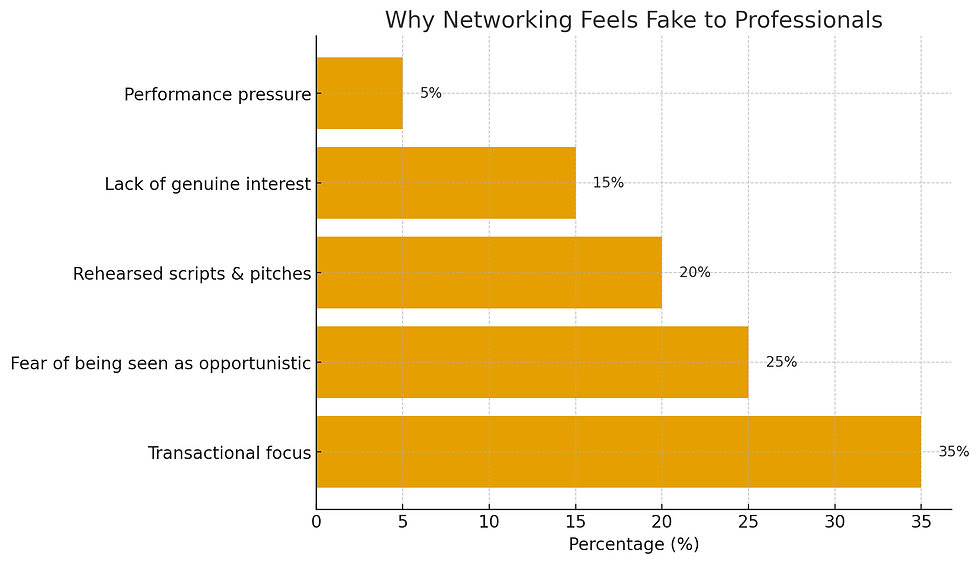Authentic Networking: Science-Backed Strategies for Building Genuine Relationships Without Feeling Fake
- Elvina Raylon Pinto

- Sep 25
- 4 min read
If you’ve ever walked into a networking event with sweaty palms, rehearsed your “elevator pitch” in your head, and still left the room feeling drained, you’re not alone.
Networking is one of the most talked-about skills in professional and entrepreneurial circles—but also one of the most misunderstood. For many, it feels forced, fake, or purely transactional. The fear of being perceived as “using” people often overshadows the genuine desire to connect.
But here’s the truth: networking doesn’t have to feel like a performance. It’s not about collecting business cards or pushing your résumé into conversations. Authentic networking is about building genuine relationships—based on trust, curiosity, and value—that last long after the event is over.
Let’s unpack how you can approach networking without feeling fake, and instead, create meaningful connections that fuel both your personal growth and professional success.
Why Does Networking Feel Fake—And Why Does It Matter?
Most professionals will admit it: networking can feel awkward. Whether it’s small talk at conferences, cold outreach on LinkedIn, or “let’s grab coffee” messages that lack substance, the discomfort is real.

Here’s why it feels fake for so many people:
Traditional networking is often transactional—focused on “what can I get” instead of “what can I give.”
People fear being seen as self-serving or opportunistic, which can damage personal credibility.
Rehearsed scripts and one-size-fits-all pitches strip away individuality, leaving interactions hollow.
Why does this matter? Because when networking feels inauthentic, we stop doing it. We retreat. And in doing so, we miss out on opportunities for mentorship, collaboration, and growth.
But when you reframe networking as a chance to learn, share, and contribute—it stops being fake. It becomes a conversation. A relationship. And often, the beginning of something much bigger.
What Makes Relationships Authentic?
The heart of authentic networking is intent. Ask yourself: Am I here to build a meaningful relationship, or am I just chasing a quick opportunity?
Authentic relationships are built on three pillars:
Trust – created through honesty and consistency.
Empathy – being genuinely curious about someone else’s story.
Value – offering something useful without expecting immediate returns.
Instead of leading with your title or résumé highlights, lead with curiosity. Ask about someone’s goals, experiences, or challenges. Listen—really listen—and reflect back what you’ve heard.
When you approach networking with the mindset of: “How can I help or learn from this person?” rather than “What can I get?”—you not only build stronger connections but also gain a reputation as someone authentic, reliable, and memorable.
Five Actionable Strategies for Authentic Relationship-Building
Here’s where science-backed, practical networking tips come into play. Try these approaches next time:
1. Ditch the Script—Communicate Your Way
Forget about the “perfect pitch.” Instead, show up as yourself. A simple personalized LinkedIn note about why you admire someone’s work is more impactful than a robotic “let’s connect.”
Tip: Reference something specific they’ve done—an article, a talk, or a project. It shows you care enough to notice.
2. Prioritize Value Creation, Not Performance
People remember how you made them feel, not how polished your pitch was. Share insights, introduce someone to a contact, or recommend a useful resource. Adding value is the fastest way to earn trust and build rapport.
Tip: Instead of asking, “What can you do for me?” ask, “How can I support you right now?”
3. Show Sincere Interest—Be a Listener
The best networkers talk less and listen more. Ask open-ended questions:
“What’s the most exciting project you’re working on?”
“What challenges are you currently facing in your industry?”
Tip: Follow up later with an article, book, or idea related to what they shared. It shows you were paying attention.
4. Don’t Oversell—Let Your Work Speak
Authenticity means owning your strengths without inflating them. Be humble, transparent, and real. Often, your work, ideas, and energy will naturally create more impact than over-polished self-promotion.
Tip: Replace bragging with storytelling. Share lessons from your journey instead of just listing achievements.
5. Build Connections Over Time
Relationships aren’t built overnight. They’re nurtured. Consistent, small touchpoints—checking in, sharing updates, or celebrating someone else’s win—strengthen bonds far more than one-off introductions.
Tip: Keep a “connection calendar.” Every week, reach out to 2–3 people just to check in. No agenda, just authentic connection.
How Authentic Networking Helps Your Career
So, why put in the effort? Because authentic networking pays off in ways that go far beyond that initial conversation.
Career Growth: Real relationships open doors to opportunities, mentorship, collaborations, and partnerships that no cold pitch can match.
Personal Branding: Being known as authentic, trustworthy, and valuable makes people want to work with you.
SEO Benefits: In the digital space, genuine relationships often lead to organic backlinks, referrals, and collaborations—which directly boost your domain authority, website traffic, and visibility.
Think of networking as planting seeds. The more genuine connections you nurture, the richer your career ecosystem becomes.
Give Yourself Permission to Network Differently
You don’t have to network like everyone else. You don’t need to memorize scripts or hand out business cards like confetti.
Networking is not a performance. It’s an ongoing, authentic conversation.
When you show up with curiosity, empathy, and a genuine desire to connect, you not only build stronger relationships but also create a reputation that lasts.
So, give yourself permission to do it differently. Because the most powerful connections in your career—and your life—will never come from feeling fake. They’ll come from being real.

_edited.png)








Comments